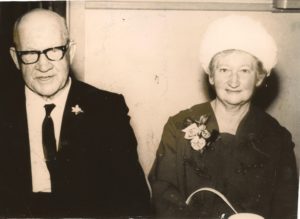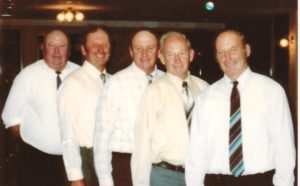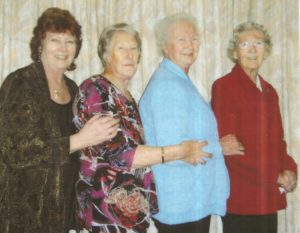Addis Arthur & Gladys Sando. Addis Arthur & Gladys Sando. Addis Arthur & Gladys Sando. Addis Arthur & Gladys Sando. Addis Arthur & Gladys Sando.
Arthur and Gladys Addis
As the eldest of the six remaining members of the above Addis family, I am penning my memoirs along with other things I learnt about the early days of Nyabing.
Our Father emigrated from Ireland around 1920, as work was scarce in his homeland. Previous to this he had served as a soldier during the 1914-18 World War. He had done active service overseas, being wounded in France and always suffered from ‘Trench Feet’ (Frostbite) as a result of being in the trenches during bitter cold winters.
His original plan was to settle in Victoria but due to his dislike of sea travel over to Australia, he disembarked at Fremantle and decided to remain in Western Australia. Father never left this state thereafter. He offered his services free to get experience on the land.
Our Mother, who was from South Australia, was visiting her married sister in Koorda when she met my father and they eventually married in 1924. They first lived at Three Springs, then Booralaming (north of Dowerin), where their property was later burnt out. At that time there was no Government assistance so they moved south, settling fifteen miles east of Pingrup. They were happy to escape the heat of the north however the isolation led them to move to Nyabing four years later. As I was only four years old at the time, my recollections are quite vague, however I do remember visiting certain families in Pingrup, the day we left and arrived in Nyabing as well as the feelings of going to bed in a strange place.
At Pingrup, we began life in a bush shed. When it rained at night, our parents huddled with my two young brothers and I, sheltering us with umbrellas. Later a two roomed corrugated iron shack was built. Father served as a member of the Nyabing – Pingrup Roads Board, now known as the Shire of Kent from 1931 – 1934.
NYABING
Whilst our Nyabing home began as a three roomed, flat roofed, corrugated iron dwelling lined with hessian bags sewn together and being the nucleus of the family home, it was to be expanded as the family grew to nine. Two makeshift front rooms were added early in the 1950’s. In 1963, a completely new home was built. In these early times, furniture was basic and makeshift. Cupboards were wooden boxes stacked side by side and on top of each other until they reached the required height, where they were then covered with floral cotton material. Our Mother’s armchair consisted of three wooden boxes, two upright with one lengthwise between, then padded and covered with material. I remember our Father making a sofa which doubled as a bed. Scraps from old clothing were used for the padding and small scraps were used for pillow and cushion filling. Lighting consisted of one small kerosene lamp and a candle. The property boasted a shed and stables, three small dams, four large paddocks and two smaller ones. The surrounding bush came close to the house, obliterating any view of our neighbour’s properties.
We led a very secluded, almost primitive life. During the early years our Father worked the farm for share croppers. I recall being afraid of the great team of horses that sometimes bolted as they looked so big to me. Later we were to have a tractor come on the scene but it frequently broke down and Father was no trained mechanic. Other sources of income came from selling mallet bark. These trees were felled, stripped of their bark and piled into bundles before being forwarded for tanning.
Selling of rabbit and kangaroo skins, old newspapers, butter, cream and eggs also assisted with our income. As we grew older, us children collected Manna Gum. Father also worked as a seasonal worker for local farmers. Added to this he worked on Government projects, one being the forming of the dam at the junction of the Pingrup and Kuringup roads and also the Harvey Weir which often took him away from home for long periods of time. He worked in all weather conditions, camping in a tent and doing for himself with no amenities. This work was hard manual labour, using nothing but a pick, shovel, crow bars, wheel-barrows and with little mechanical assistance if any. These were long, hard and lonely times for Mother too, with only us children for company and no other outside contact.
As children, we would wander through the bush finding beehives to rob the honey, set rabbit traps and kangaroo snares, watch birds nesting, collect wildflowers and mushrooms when they were in season. We had jobs to do that included bringing in and milking the cows, feeding the pigs and fowls, gathering eggs and filling the wood boxes. We owned one tricycle and a game of Ludo between us. We saw few people but shared alternate weekend visits with the Goodchild children. As a young child I could not understand why I couldn’t wear trousers with braces like my brothers. For many years our only transport was a horse and cart, so we took turns going to Nyabing for the groceries with whichever parent. We had to behave and not run around like some other children and naturally became very shy and acquired an inferiority complex.
Our diet was poor and mainly fried in dripping or lard, sometimes just bread and dripping. We seldom had fresh fruit and vegetables or meat unless rabbit or kangaroo was available. Potatoes, onions and dried peas were our main source of vegetable and dried apples and apricots our fruit. Milk, cream, butter and eggs were usually plentiful. Our Mother was adept at producing stews, pies, pasties etc from tin meat and really innovative at producing tasty meals from basic ingredients. Our days began with porridge or bread and milk and often ending with bread and golden syrup, treacle or the rare luxury of jam for spread. The tall tins of these items were made into billies or used as biscuit tins, while the squat ones were used as utensils for cooking cakes and puddings. We always had a plain, but iced cake for birthdays. Christmas was special too with fruit cake, pudding and perhaps a bottle of lemonade but no presents on either occasion.
Toasting forks and soap savers were made from wire and our clothing (so often shapeless garments) were made from anything available. Flour was bought in calico bags which were used for pillow slips, tea towels and linings etc. The less worn parts of old sheets became underwear, handkerchiefs and dish cloths. Nothing was ever wasted. People handed on outgrown clothes and shoes. The CWA, collected used clothing for needy families. Recycling was simply another name for ‘making do’. Generally people accepted their lot, not expecting too much from life and were contented and proud of how they coped. Our bedding was simple, old rugs, coats and woggers (bags sewn together). Mother made her own bread and even now I can imagine the wonderful aroma of her freshly baked bread and crusty cottage loaves made for our enjoyment. We also made our own butter, with all of us taking turns at what seemed like endless hours of churning.
Despite the poor diet, we were remarkably healthy, possibly because of our outdoor lifestyle and because we didn’t mix much. Once I overheard Mother crying and saying to Dad that she didn’t know how she was going to feed the children. Sometimes we were served bread and butter sprinkled with salt and pepper and poured over with hot water, this we called ‘buttery slops’.
At the age of eight, I was borrowed and lived with another family for three years to keep their small school going. This was a traumatic experience as I had seldom been anywhere and never away overnight. I didn’t know these people and was terribly homesick. My older brothers were billeted by other families but for shorter periods of time. Prior to this, we had no formal education, except for Lindsay who did correspondence briefly. Lindsay became self educated and did well in life. He married and had four children.
Murray attended school for four years then worked on local farms before buying his own property, eventually marrying and having three children and later moving to Albany. I was more fortunate. Schooling came easily to me and I had three years at Albany High School. The younger family members began school at an earlier age. All the boys left school at fourteen or earlier. They all began work in various aspects of farming but didn’t all continue.
I worked in the office of Richardson & Co in Katanning prior to marrying Fred Larter, a Nyabing farmer. We had two daughters. When the eldest required high schooling, we re-located to Katanning rather than sending them to boarding school.
My brother Garth, on marrying, took up land eleven miles south of the home property. Garth and Jo had three children. Trevor remained on the home block and married a widow with three daughters, eventually moving to Albany. Verlie attended Albany High School and worked in Katanning for several years, where she still lives. Barrie helped on the farm and worked on neighbouring ones, finally buying his own place which he gave up for health reasons. He married a widow and helped bring up her six children. Ailsa also attended Albany High School, spending her working days in Katanning where she married and still lives, having had two children. Jan didn’t go away to school, nor to work. After leaving school she remained on the farm and helped at home. She married and had two children and now lives at Narrikup.
Our Father joined the army in World War II, becoming a Sergeant and Training Instructor at the Northam camp. Mother finally had a little money. Our parents had struggled financially most of their married life and when in 1954 Father won £2,000 in Lottery, they purchased their first car. By now they were again farming the property and life was becoming a little easier.
I look back and admire how Mother coped with the poverty and loneliness in bringing up nine children on her own for months at a time with no outside communication and seldom seeing another adult. Despite the disadvantages, Mother remained well spoken and when she could afford, would dress accordingly, able to enjoy an improved lifestyle that she certainly deserved after her years of battling hardship.
Our Father passed away in 1969 and Mother remained on the farm with Trevor for another four years before moving to Katanning. Trevor remained at Nyabing until selling the farm and moving to Albany.
All the ‘Addis’ descendants, except for one grandson and his family who moved to Queensland, still reside in Western Australia. Only Garth’s widow Jo and their daughter Alison remain in Nyabing. The family still call Nyabing ‘home’ and all enjoy re-visiting and catching up with the locals and reminiscing.
Now I greatly appreciate our better homes and present day living standards.
Arthur & Gladys’ children
The Boys: L-R approx 1980’s
Murray, Trevor, Garth. Lindsay, Barrie Addis.
The Addis Girls in 2011:
Janine O’Neill, Ailsa Thomas, Verlie Addis & Lorna Larter
Return to NYABING PEOPLE Page
Return to NYABING Page
Return to HOME Page
Go to our FACEBOOK Page
Visit the LOST NYABING Website



